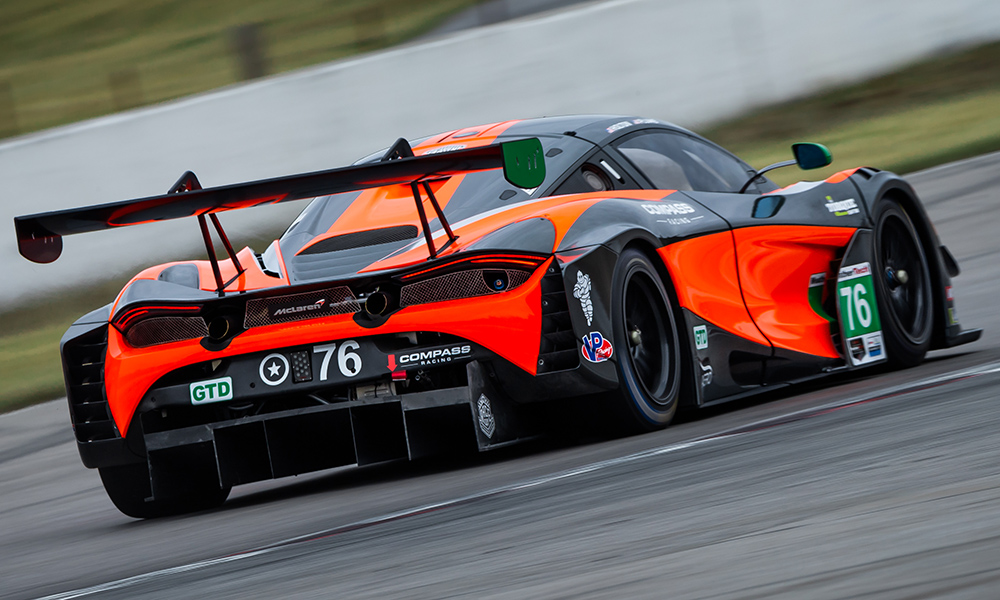
Photo: Jordan Lenssen/McLaren
A freeze in the level of aero development is on the agenda for the next set of GT3 regulations according to Stephane Ratel, who is pushing for no fundamental changes to the platform.
Discussions on the next cycle of GT3 regulations, due in 2022, have been ongoing in recent technical working group meetings, with the FIA having inquired with manufacturers on potential evolutions to the category.
While an option for a dual platform homologation concept is understood have been shelved, other areas are being examined, according to the SRO Motorsports Group founder and CEO, who is a major proponent of GT3 racing worldwide.
“There is a wish to stop the increase of aerodynamic development,” Ratel told Sportscar365.
“It’s not to clip cars, and even if we could limit it or stop it eventually, reduce it a little bit now because we are seeing more gutters and flaps. Aero development of the car is complex and it’s what costs money.
“The costs of running these cars, in terms of costs-per-mile with engine and transmission, in fact, they are becoming stronger and stronger; the durability has increased. That’s not the problem.
“The problem is the aero sophistication; the costs of the parts and that’s what teams damage in racing.”
Ratel explained that the costs of spare bodywork to teams, and not necessarily the development costs for manufacturers, is the concern.
“That’s the thing you need to [replace], so that grows the cost of GT3,” he said. “So we need to be careful, in the costs and sophistication of all these parts.”
Ratel downplayed previous discussions of a possible fundamental shift in the platform’s architecture that would have seen large sports coupes, such as the BMW M6 GT3 and Bentley Continental GT3, fall under a different set of regulations to pure-bred sports cars.
He insisted there was never a proposal from the FIA but rather a questionnaire given to manufacturers, which largely opposed the dual-platform concept.
Instead, Ratel feels the current regulations, which allows for a large amount of technical waivers to certain cars, is working successfully as-is.
“It’s a no-brainer if you want to balance a Bentley Continental with a Ferrari you are going to have to give a vast amount of waivers to Bentley to be able to compete with the Ferrari. That’s a fact of life. You have to do it.
“I think they’re doing a pretty good job.”
Ratel: GT3 Must Remain for Premium Manufacturers, Iconic Models
Ratel, however, has stressed that GT3 must not stray away from its current philosophy.
“At the end of the day, the FIA needs to decide and we need to be clear in one thing. GT3 is for premium manufacturers and/or iconic models,” he said.
“Nissan may not be a premium [brand] in a sense but the GT-R is an iconic model.
“When you apply BoP, you need to respect the marketing value of all these manufacturers. It’s no point trying to invent class platforms because you outlaw the people you want to have.
“It’s a fact that we want some cars in because they correspond to the marketing value of the brands.
“If there was no Balance of Performance, who cares, but with BoP, you’re balancing… We need to respect that and the FIA can try all the regulations in the world but there needs to be a committee decision to say, ‘Yes this model is acceptable and this one is not.’
When asked if he feels there are any current GT3 cars outside of the outlined criteria, Ratel said it’s “OK” at the moment.
“But we are at the limit to be careful,” he said. “We only have premium brands and iconic models.”
Goal is to “Control the Growth” of Platform
Ratel, meanwhile, remains bullish on the future of GT3, which has continued to see growth in key markets worldwide.
“The success of the category is there, looking globally the number of cars racing,” he said. “There is no major change [planned]. Let’s control it and hope it will continue.
“GT3 has been [increasing] with more cars, more manufacturer involvement, more championships, more teams, more races, more everything.
“If you look at the ratio on the number of laps done by GT3 cars around the world has been [going up]. That’s very rare.
“For 13 years, looking at the history of motorsport, that it’s been going up and up and up. Why change it? Let’s control the growth and avoid that it goes crazy and we can still be here in 13 [more] years.”
























